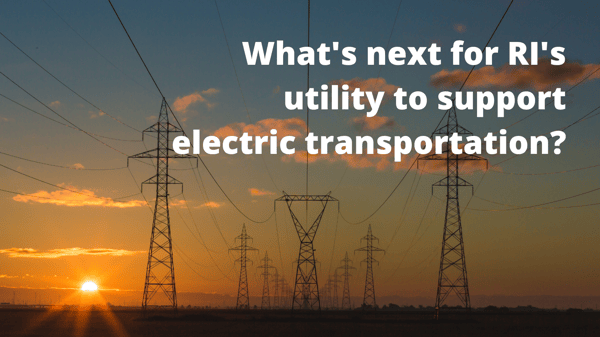 Rhode Island is in good shape to reduce emissions from the power sector after a successful 2022 legislation session. But it’s slow-going on policy to support vehicle electrification, which is an absolute necessity to displace gasoline use and meet 2030 climate goals.
Rhode Island is in good shape to reduce emissions from the power sector after a successful 2022 legislation session. But it’s slow-going on policy to support vehicle electrification, which is an absolute necessity to displace gasoline use and meet 2030 climate goals.
This blogpost is about how the state’s new utility company and policy-making at the regulatory level will impact Rhode Islanders' ability to switch to an electric vehicle (EV).
Background: What does the utility company have to do with electric vehicles?
You might not realize it, but the state’s electric utility company has been investing a lot of money into building EV charging stations. In 2017, National Grid proposed a three-year program to support EV adoption. The programs included:
- Efforts to install charging stations at multi-unit residential buildings, workplaces, environmental justice areas, and bus depots.
- A pilot program to encourage EV drivers to charge off-peak.
- A fleet assessment program to help large vehicle fleets identify opportunities for EVs.
- A discount program to make owning and operating a commercial charging station more affordable.
For a sense of scale, here’s a map of 450 charging ports installed with utility support over the last few years:
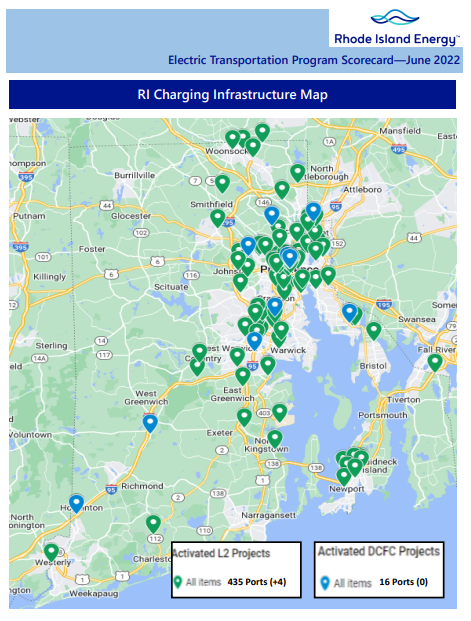
The sale of National Grid to “Rhode Island Energy”
In June 2022, the transfer of Rhode Island’s utility business from National Grid to PPL was approved through a settlement process. The new utility is known as Rhode Island Energy.
Attorney General Neronha deserves credit for negotiating a good deal on behalf of Rhode Islanders, especially to forgive overdue utility bills for people who got behind on their payments during the pandemic and to require Rhode Island Energy to cover the costs of the acquisition without passing them along to ratepayers. It’s also good news that the staff with experience running the EV programs in Rhode Island are staying with the new company.
However, there’s a catch; the entire process to review and approve the sale has put the development of new clean energy programs on pause while existing programs were winding down.
Though the EV programs were supposed to last for three years, the pandemic stretched their timeline. The utility’s EV programs are now due to expire at the end of August 2022. Rhode Island Energy, under the settlement’s terms, has agreed to put a hold on proposing any new rate cases for three years. And without a rate case to review, approve, and cover the cost of new programs, it’s unclear how the next iteration of EV-supportive programs will move forward.
A murky future for utility EV programs is bad news for the climate
The murky future for utility-scale EV programs is part of the reason Green Energy Consumers Alliance strongly supported legislation (the Electric Transportation Act) in 2022 that directed the utility company to offer incentives for off-peak charging that reflect the full avoided costs of shifting EV load to off-peak times. (For more information about what off-peak charging is, see this blog.)
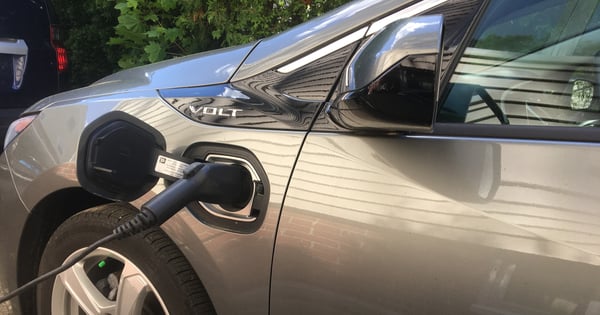
Though the Electric Transportation Act failed to move this session, the Public Utilities Commission (PUC – a regulatory agency responsible for overseeing the utility) submitted a letter opposing the policy to encourage off-peak charging on the basis that EV programs should be considered holistically as part of the next rate case. The PUC’s fear is that designing EV-specific rates could lead to a patchwork of programs that don't all make sense together. They would rather wait until Rhode Island has a smart grid and advanced meters to collect data to inform the development of time-of-use rates that apply to all electric load, not just EVs.
We at Green Energy Consumers Alliance agree with the PUC that it’s crucial to be efficient with ratepayer dollars and prioritize policies and programs that will keep rates as low as possible. Grid modernization and advanced meters (plans under development now) will provide the foundation to transition to 100% renewables by 2033, heat pumps, and EVs.
But the PUC is letting the perfect be the enemy of the good. At this crucial stage of EV adoption, letting the existing programs lapse without a replacement will be a huge blow to EV adoption. Waiting until 2025 to propose new EV programs and 2026 to implement them, which is what will happen if policymakers do nothing, will lead to a failure of Rhode Island to meet its obligation under the Act on Climate.
How to move forward: Principles for smart utility policy to support EVs
In the long run, there should be on-bill discounts for EV drivers who charge their EVs when it’s least taxing to the system. Those discounts should extend to people who avoid using their dishwashers and laundry machines during peak times, like the PUC wants. (Green Energy Consumers Alliance has run a Shave The Peak program for years to encourage consumers to voluntarily minimize electricity use at peak times to reduce emissions. Those people should receive an economic incentive through the utility!)
In the short term, Rhode Island cannot simply sit and wait. State policy on EVs is going to determine whether we meet the 2030 climate goal or not (particularly because federal action on EVs is looking bleak).
EVs deserve special treatment in rate design because...
1. EV-specific rates will drive EV adoption. There is no way for Rhode Island to meet its climate mandate without aggressive uptake in EV adoption. We estimate that Rhode Island needs 100,000 EVs by 2030 to satisfy the emissions limit. EVs are cheaper as fuel than gasoline, but the greater the savings, the more drivers are incentivized to switch to EVs. Rhode Island has high electric rates, which work against the cost-effectiveness of switching to an EV. A recent survey by JD Power found that fuel savings are the number one reason that drivers are switching to EVs. EV-specific rates will make EVs more competitive with gasoline and help more drivers see the value of driving an EV.
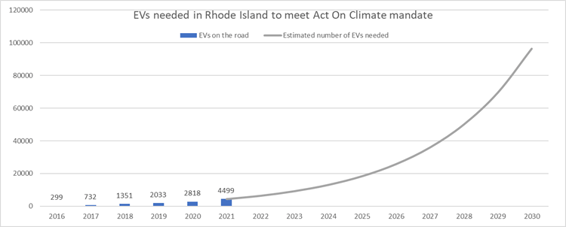
The figure above illustrates how many new electric cars must replace gas-powered cars for Rhode Island to meet its 2030 climate mandate. The steep slope of the curve means policymakers need to use every tool in the toolbox to stay on track.
 2. EV-specific rates are a financially-sustainable way to encourage drivers to switch. Incentives to lower the upfront cost of EVs are a popular policy in many states. Until very recently, Rhode Island hasn’t had a purchase incentive since 2017 because it’s difficult to sustain. The latest DRIVE EV program has a budget of just $1.25 million – enough for 600 EVs. It's unlikely that, with so many competing priorities, the state finds millions of dollars under the cushions in the State House to establish a multi-year incentive. Lowering fuel costs through smart utility policy can create an incentive that is paid for by savings from the system by managing electricity more efficiently.
2. EV-specific rates are a financially-sustainable way to encourage drivers to switch. Incentives to lower the upfront cost of EVs are a popular policy in many states. Until very recently, Rhode Island hasn’t had a purchase incentive since 2017 because it’s difficult to sustain. The latest DRIVE EV program has a budget of just $1.25 million – enough for 600 EVs. It's unlikely that, with so many competing priorities, the state finds millions of dollars under the cushions in the State House to establish a multi-year incentive. Lowering fuel costs through smart utility policy can create an incentive that is paid for by savings from the system by managing electricity more efficiently.
3. EVs are coming whether policy prepares our infrastructure or not; EV-specific rates good charging behavior that leads to cost savings for everyone. Whether or not Rhode Island meets its climate goals, more EVs are coming. As adoption increases, EV drivers are going to add a lot of new load to the electric grid. This is a fundamentally different situation to manage and respond to than the effort to better manage refrigerators, air conditioners, dishwashers, laundry machines, and toasters. EV-specific rates will incentivize drivers to charge when it’s least taxing to the system, which means fewer infrastructure upgrades will be needed to support the EVs that are coming. Smart charging behavior is a good norm to establish early, and it will be much harder to change charging habits the longer we wait.
4. EVs are flexible load, easy to schedule, and it’s possible to collect data on the electricity they use without smart meters, which won't come into play until 2026. Modern EVs come with the ability to schedule charging directly in the vehicle and by cell phone. Level 2 charging stations also allow for scheduling. The same technology can allow utilities to collect data on how each EV driver is charging to deliver on financial incentives for charging off-peak or ramping charging down when the grid is overloaded. We don’t need to wait until we have a modernized grid to start to implement solutions that will work for EVs.
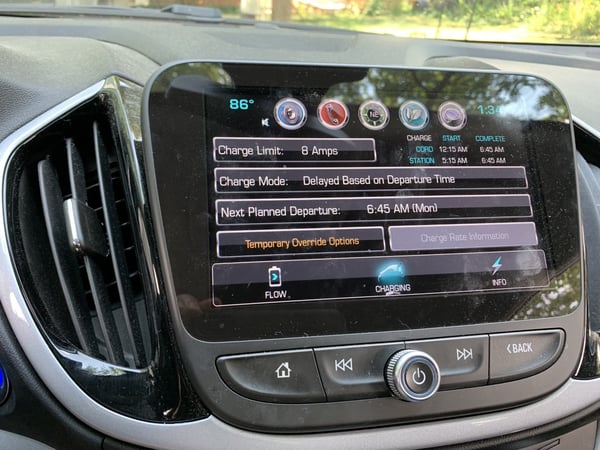 EV drivers can schedule charging directly in their vehicle. Data collected through vehicle telematics or on-board devices can help utilities deliver cash rewards to drivers who charge during off-peak times without waiting for smart meters.
EV drivers can schedule charging directly in their vehicle. Data collected through vehicle telematics or on-board devices can help utilities deliver cash rewards to drivers who charge during off-peak times without waiting for smart meters.
What happens next?
In the coming months, Green Energy Consumers is going to continue our efforts to make sure that policymakers in Rhode Island understand the benefits of EV-specific programs and prioritize their continuation. Here’s our plan:
- We are going to support Rhode Island Energy’s coming proposal to extend their existing EV programs for another year. We want to see an off-peak charging program available to lower fuel costs for EV drivers and defer the expansion of new infrastructure that would otherwise be needed if more electricity is consumed at peak times.
- We are going to support the utility’s plans to install smart meters and grid modernization, which are going to enable electrification of our transportation and heating systems alongside the state’s mandate to increase renewable electricity to 100% by 2033.
- We are going to support legislation in 2023 that makes sure that the utility company is equipped to support electric load from 100,000 EVs by 2030.
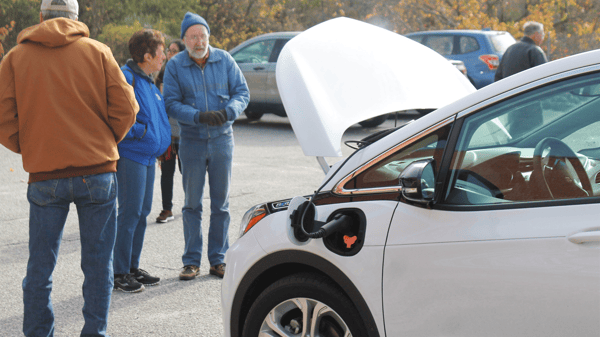
 Rhode Island is in good shape to reduce emissions from the power sector after a successful
Rhode Island is in good shape to reduce emissions from the power sector after a successful 


 EV drivers can schedule charging directly in their vehicle. Data collected through vehicle telematics or on-board devices can help utilities deliver cash rewards to drivers who charge during off-peak times without waiting for smart meters.
EV drivers can schedule charging directly in their vehicle. Data collected through vehicle telematics or on-board devices can help utilities deliver cash rewards to drivers who charge during off-peak times without waiting for smart meters.
Comments